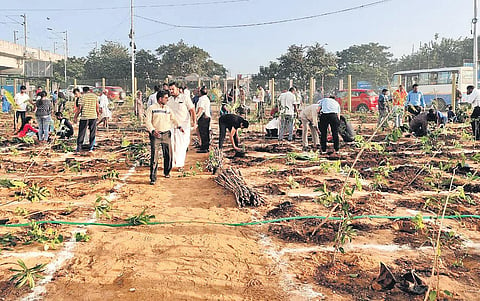

CHENNAI: First came urbanisation that killed many of the trees that had lined the city’s streets. Then came cyclone Vardah that uprooted even the strongest of those left behind. Amid all this damage — and summers made more scorching — several NGOs, institutions and eco-warriors have been toiling to rebuild the city’s green cover over the past four years. Adding support to this, the Chennai Corporation has planned to create a ‘Mini Forest’ by planting saplings through the Miyawaki method — the Japanese way of planting more trees in less space, but with a faster growth rate. The first of it was created in Kotturpuram on January 25 in an area spanning 20,734 square feet land at a cost of Rs 20 lakh. Around 2,000 saplings of 40 varieties, including naval maram (Java plum), thekku maram (Teak), and iluppai (Mahua), were planted in the method.
Effectiveness
In the 1980s, Japanese botanist Akira Miyawaki introduced this method of reforestation to restore indigenous ecosystems. Under this method, the top-soil of a selected region is replenished to a depth of 20 cm to 30 cm by mixing soil and organic compost. According to a 2010 journal on the effectiveness of the Miyawaki method, positive afforestation results were observed in many parts of the world in just two years, whereas it normally takes a decade for trees to achieve complete growth.
The journal says this is a reliable way to create “native forest by native trees”. It takes four days to set up a tree in the Miyawaki method. The pits are dug and left to dry for one day. Then, various ingredients for manure like sugarcane bagasse, vermicompost, dry leaves, coco peat and other manure are mixed with sand and dumped in the dry pit for three days before planting the sapling. To expand, the civic body is set to plant more such trees in open spaces.
Popularising this style
Popular across the world, the Miyawaki method is being rapidly adopted in India’s urban spaces. Several industries, factories and residential apartments in metropolitan cities are using this method to increase the green cover amid the concrete jungle. There are also training classes conducted in the city by professionals, like city-based NGO Thuvakkam, for adopting Miyawaki in industries and public spaces. “Plans are in place to extend planting trees in the Miyawaki style in various Corporation parks under the funds of `40 crore allotted for the private maintenance of parks,” said a Corporation official.
“NGOs too can reach out to the Corporation to plant trees in the Miyawaki style in these parks,” added the official. On the other hand, the Chennai Rivers Restoration Trust (CRRT) too is planning to plant saplings, few in the Miyawaki style, along the banks of the Cooum River. The CRRT plans to plant saplings to a total length of 60 km, 30 on each side, from the mouth of Cooum to Parithipattu at a cost of `36.61 crore in the next two years. Tenders will be finalised by February 22, said officials.